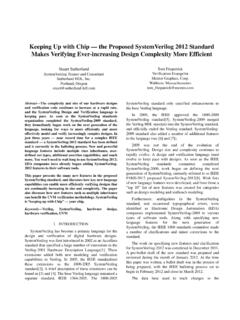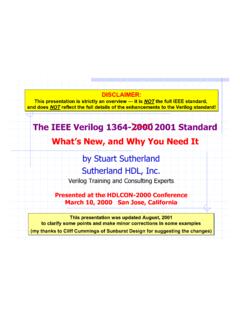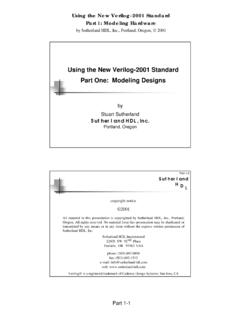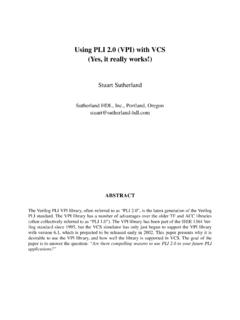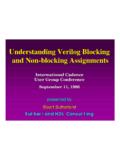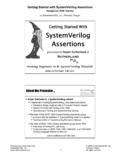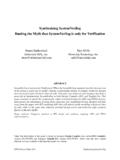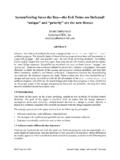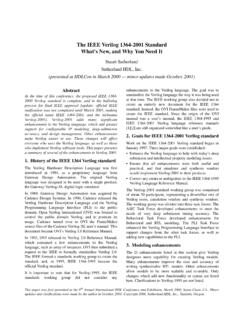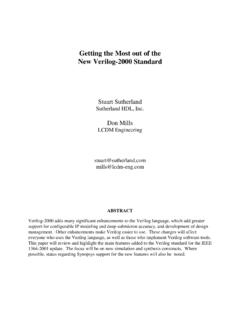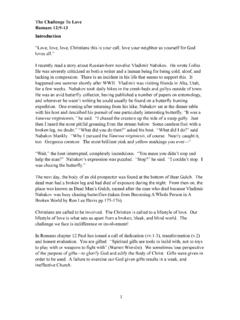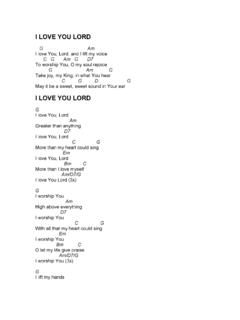Transcription of I'm Still In Love with My X - Sutherland HDL
1 2013, Sutherland HDL, at DVCon-2013, San Jose, CA1I m Still In love with My X!(but, do I want my X to be an optimist, a pessimist, or eliminated?)Stuart SutherlandSystemVerilog Trainer and ConsultantSutherland HDL, , This paper explores the advantages and hazards of X-optimism and X-pessimism, and of 2-state versus 4-state simulation. A number of papers have been written over the years on the problems of optimistic versus pessimistic X propagation in simulation. Some papers argue that Verilog/SystemVerilog is overly optimistic, while other papers argue that SystemVerilog can be overly pessimistic.
2 Which viewpoint is correct? Just a few years ago, some simulator companies were promising that 2-state simulations would deliver substantially faster, more efficient simulation run-times, compared to 4-state simulation. Now it seems the tables have turned, and Verilog/SystemVerilog simulators are providing modes that pessimistically propagate logic X values, with the promise that 4-state simulation will more accurately and efficiently detect obscure design bugs. Which promise is true? This paper answers these Verilog, SystemVerilog, RTL simulation, 2-state, 4-state, X propagation, X optimism, X pessimism, register initialization, randomization, UVM1.
3 INTRODUCING MY XSystemVerilog uses a four-value logic system to represent digital logic behavior: 0, 1, Z (high-impedance) and X (unknown, uninitialized, or don t care). Values 0, 1 and Z are abstractions of the values that exist in actual silicon (abstract, because these values do not reflect voltage, current, slope, or other characteristics of physical silicon). The fourth value, X, is not an abstraction of actual silicon values. Simulators can use X to indicate a degree of uncertainty in how physical hardware would behave under specific circumstances, , when simulation cannot predict whether an actual silicon value would be a 0, 1 or Z.
4 For synthesis, logic X provides design engineers a way to specify don t care conditions, where the engineer is not concerned about whether actual hardware will have a 0 or a 1 value for a specific values are useful, but can also be a challenge for design verification. Of particular concern is how X values propagate through digital logic in RTL and gate-level simulation models. A number of conference papers have been written on this topic. The title of this paper is inspired by two earlier papers on X propagation, The Dangers of Living with an X by Turpin [1] and Being Assertive with Your X by Mills [2], presented in 2003 and 2004, respectively.
5 Both the SystemVerilog standard and SystemVerilog simulators have added many new features since those papers were written. This paper reiterates concepts and good advice from earlier papers, and adds coding guidelines that reflect the latest in the SystemVerilog language and software tool : For the purposes of this paper, X-optimism is defined as any time simulation converts an X value on an expression or logic gate input into a 0 or a 1 on the result. X-pessimism is defined as any time simulation passes an X on an input to an expression or logic gate through to the result.
6 As will be shown in this paper, sometimes X-optimism is desirable, and sometimes it is not. Conversely, in different circumstances, X-pessimism can be the right thing or the wrong : In this paper, the term value sets is used to refer to 2-state values (0 and 1) and 4-state values (0, 1, Z, X). The term data types is used as a general term for all net types, variable types, and user-defined types. The terms value setsand data types are not used in the same way in the official IEEE SystemVerilog standard [3], which is written primarily for companies that implement software tools such as simulators and synthesis compilers.
7 The SystemVerilog standard uses terms such as types , objects and kinds , which have specific meaning for those that implement tools, but which this author feels are neither common place nor intuitive for engineers that use the SystemVerilog HOW DID MY ONE (OR ZERO) BECOME MY X?Logic X is a simulator s way of saying that it cannot predict whether the value in actual silicon would be 0 or 1. 2013, Sutherland HDL, at DVCon-2013, San Jose, CA2 There are several conditions where simulation will generate a logic X: Uninitialized 4-state variables Uninitialized registers and latches Low power logic shutdown or power-up Unconnected module input ports Multi-driver Conflicts (Bus Contention) Operations with an unknown result Out-of-range bit-selects and array indices Logic gates with unknown output values Setup or hold timing violations User-assigned X values in hardware models Testbench X Uninitialized 4-state variablesThe SystemVerilog keywords that will declare or infer a 4-state variable are: var, reg, integer, time, and, depending on context, logic.
8 The var keyword explicitly declares a variable. It can be used by itself, or in conjunction with other keywords. In most contexts, the var keyword is optional, and is seldom integer i1; // same as "integer i1"var i2; // same as "var reg i2"Example 1: The var variable typeThe logic keyword is not a variable type or a net type. Nor is the bit keyword. logic and bit define the digital value set that a net or variable models; logic indicates a 4-state value set (0, 1, Z, X) and bit indicates a 2-state value set (0, 1). The reg, integer, time and var. variable types infer a 4-state logic value logic keyword can be used in conjunction with the var, reg, integer or time keyword or a net type keyword (such as wire) to explicitly indicate the value set of the variable or net.
9 For example:var logic [31:0] v; // 4-state 32-bit variablewire logic [31:0] w; // 4-state 32-bit netExample 2: 4-state variable and net declarationsThe logic (or bit) keyword can be used without the varor a net type keyword. In this case, either a variable or net is inferred, based on context. If logic or bit is used in conjunction with an output port, an assign keyword, or as a local declaration, then a variable is inferred. If logicis used in conjunction with an input or inout port declaration, then a net of the default net type is inferred (typically wire). An input port can also be declared with a 4-state variable type, using either the keyword triplet input var logic or the keyword pair input var.
10 Module m1 (input logic [7:0] i; // 4-state wire inferredoutput logic [7:0] o; // 4-state var inferred);logic [7:0] t; // 4-state var 3: Default port data typesThe SystemVerilog standard [3] defines that 4-state variables begin simulation with an uninitialized value of X. This rule is one of the biggest causes of X values at the start of simulation. Uninitialized registers and latches Register and latch refer to models that store logic values over time. This storage behavior can be represented as either abstract RTL procedural code or as low-level User-defined primitives (UDPs). Most often, the storage of registers and latches is modeled with 4-state variables, such as the reg data : The reg keyword does not, in and of itself, indicate a hardware register.
